When I was the guest on the RevZilla Highside/Lowside podcast last fall to talk about the current state of the sport-touring segment of motorcycling, I made the case that while it may seem like the traditional sport-touring motorcycle has nearly disappeared, there are actually still more of them than you think.
It’s understandable. The segment has evolved and just about all the recent new models that aim at the sport-touring mission are street bikes that carry over some DNA, or at least some of the looks and ergonomics, of adventure-touring motorcycles. Those are the ones that have gotten most of the attention in recent years. I’m talking motorcycles like the Ducati Multistrada, the Kawasaki Versys 1000 SE LT+, the Yamaha Tracer 9 GT. They lack any pretense of off-road capability but they still have that tall stance and a little of the look of an adventure-tourer, just as in the automotive world crossovers have brought a little SUV attitude to what are basically cars. It’s easy to think the traditional sport-touring motorcycle — which I define as a sport bike made more comfortable for touring or a touring bike given higher performance levels — has disappeared.
Really, though, there’s more of them than you think, from the Kawasaki Ninja 1000SX to the Yamaha FJR1300ES to the Kawasaki Ninja H2 SX SE to the BMW R 1250 RS and, arguably, two very sporty Italian bikes that have side cases available, the Aprilia Tuono V4 and Ducati SuperSport 950. And now, there’s an interesting new entry that very much fits the traditional mold of taking a sport bike and giving it some touring capability with more comfortable ergonomics, luggage capacity and wind protection: the 2022 Suzuki GSX-S1000GT+. And I just had the chance to do a two-day, 600-mile test ride. Here’s how it went.
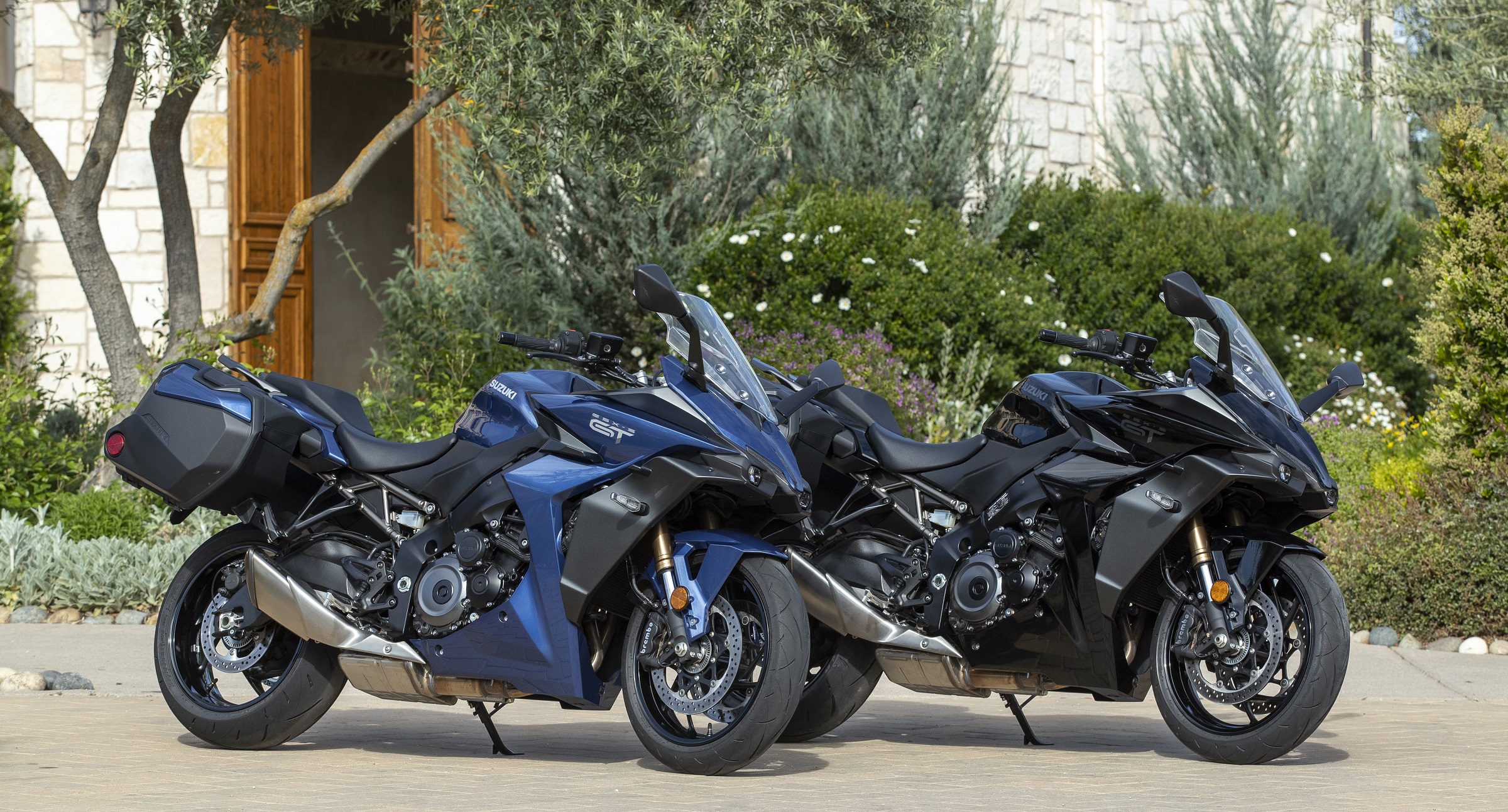
The Suzuki GSX-S1000GT+ is available in the United States in Metallic Reflective Blue and Glass Sparkle Black colors. Photo by Kevin Wing.
Sport bike heart and muscle meets touring
Suzuki is known for its GSX-R line of sport bikes and the 999 cc inline-four engine comes from that heritage. It’s what Suzuki calls its “long-stroke engine” and while it has been updated and refined many times, it traces its lineage back to the 2005 GSX-R1000 sport bike. Race-replica sport bikes have gotten ever more radical, more single-minded in their pursuit of lap times at the track. The new 999.8 cc engine in the current Suzuki GSX-R1000R that serves as the basis for its World Superbike effort has a 55.1 mm stroke compared to the 59.0 mm stroke in the GSX-S1000GT+. The shorter stroke allows a higher redline, which is great for racing, but the older engine is easier to live with on the street, where redline in even first gear will earn you a serious performance award from law enforcement.
“The GSX long-stroke engine is sort of the small-block Chevy of Suzuki,” said Communications Manager Richard Kimes. “You can take it in a lot of different directions.”
Previously used in the GSX-S1000 naked bike and the GSX-S1000F, which added a fairing, the engine has now been taken in a more sport-touring direction. The F has been dropped, leaving two very different models in the GSX-S line that will have no overlap and will better serve more riders.
To create the GSX-S1000GT+, Suzuki kept the aluminum twin-spar frame, high-quality Brembo brakes, a quickshifter, and adjustable suspension for the sport side of the equation. For touring ability, it added a full fairing, cruise control, upright ergonomics, and color-matched, locking side cases keyed to the ignition.
This is the classic recipe for a sport-touring motorcycle: Make it comfortable and practical enough that you can pack for a weekend trip and ride long distances to get to your destination but keep it sporty enough that when you get to the fun roads, it’s still a joy to ride at a brisk pace.
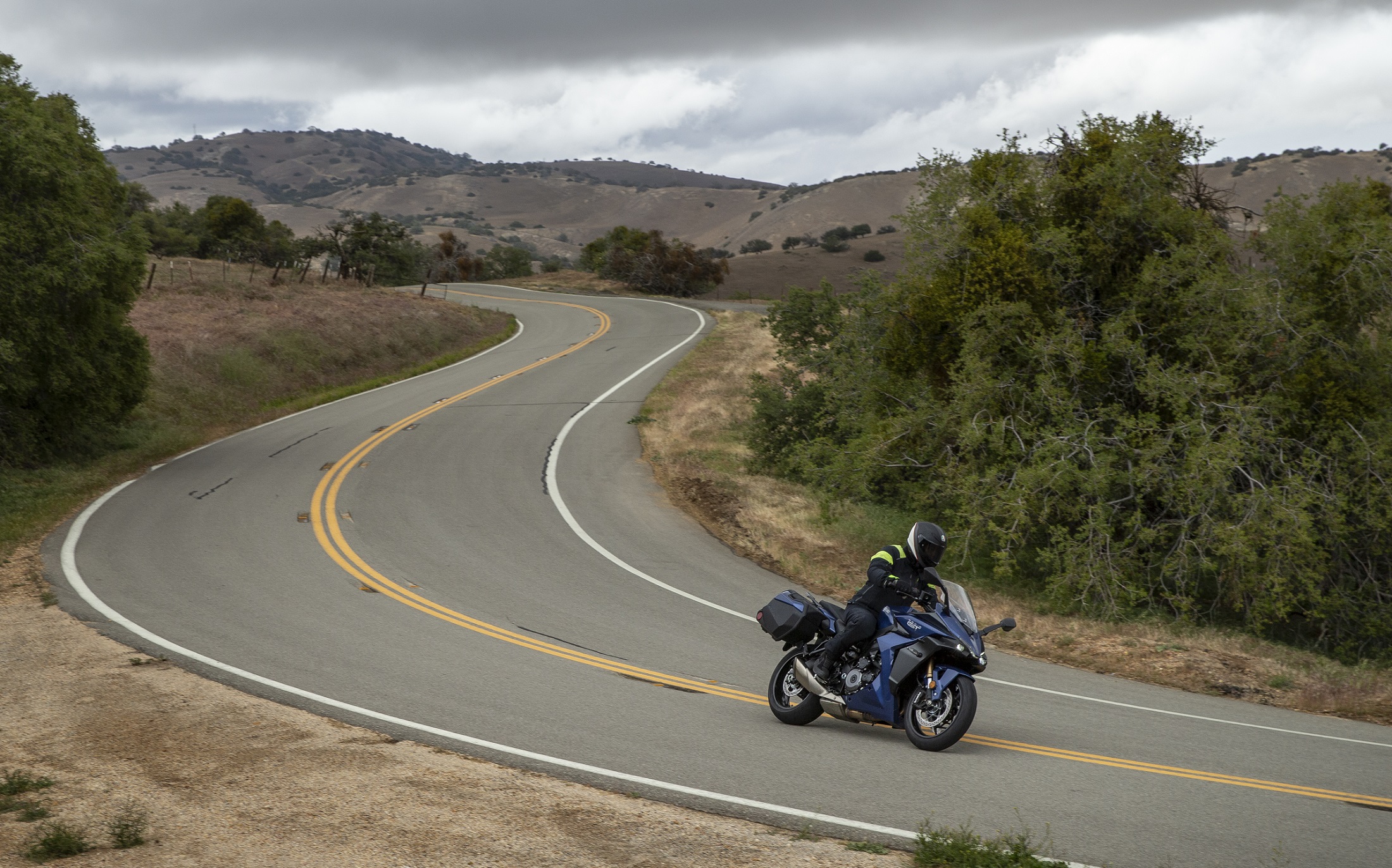
The recipe for a successful sport-touring motorcycle: comfortable enough for long and multi-day trips and still fun to ride when you get to the really good roads. Photo by Kevin Wing.
Riding the Suzuki GSX-S1000GT+
That’s the ride Suzuki laid out for us. We started out with 30 miles of white-knuckle lane-splitting through Southern California freeway traffic (“white-knuckle” because jumping on an unfamiliar motorcycle and trying to follow a fast-riding local through weaving traffic while wondering to myself, “Just how wide are those saddlebags?” is a challenging way to start the morning), then moved on to some of the great mountain roads outside Ojai and finished up with a freeway slog to our hotel in Paso Robles in a chilly rain. In other words, a little of everything, which is often how a weekend sport-touring excursion goes.
As mentioned already, while the overall bike slots in at the sporty end of the sport-touring spectrum, the ergonomics are relaxed. The tapered aluminum handlebar is high and wide and put me in a very slight forward lean, as you can see in the photo below, which shows the riding position. I didn’t have any issues with the leg room, though I know from past experience that what feels OK to me is too cramped for many riders on a long day.
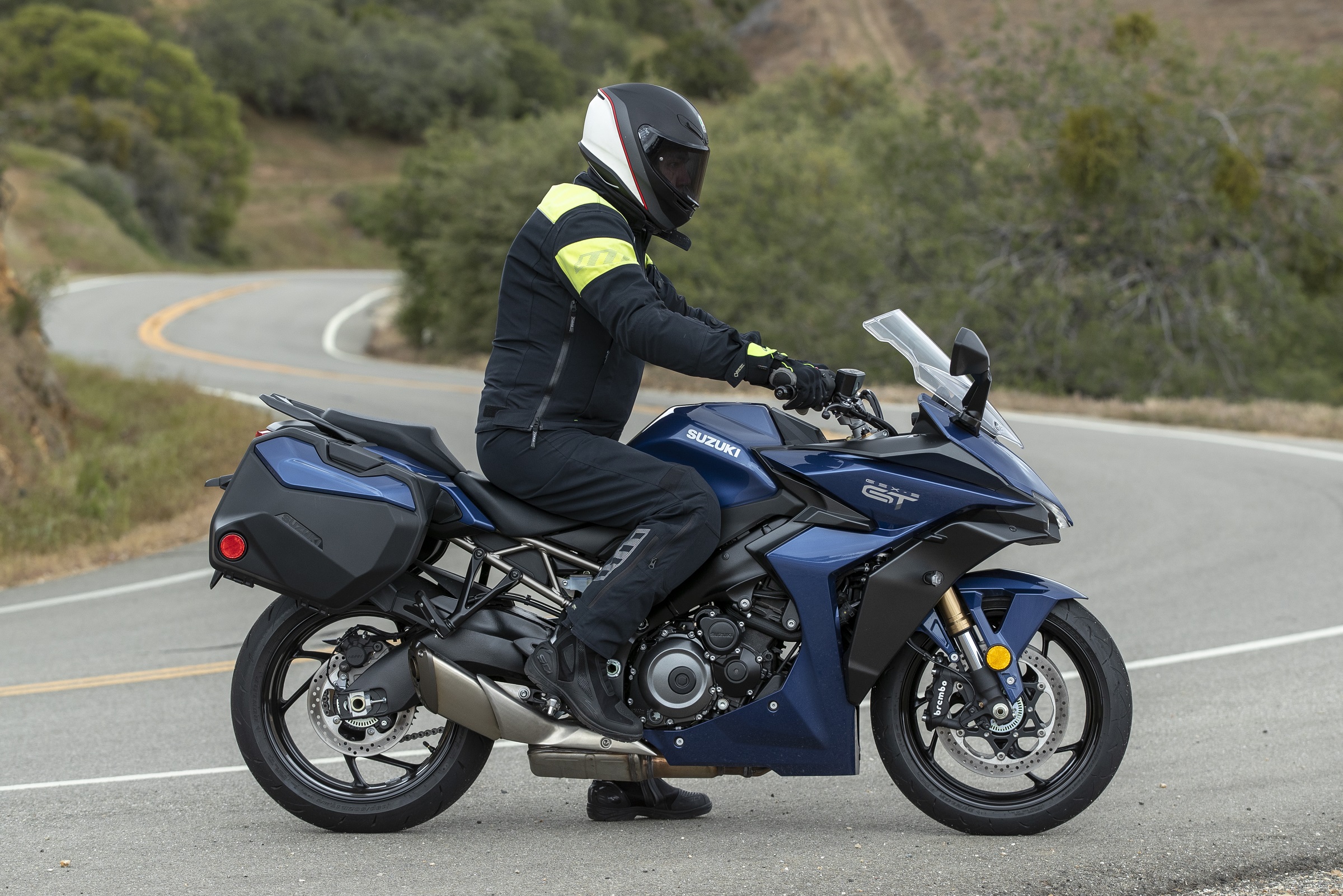
For reference purposes, I am five feet, 11 inches tall with a 32-inch inseam. The Suzuki GSX-S1000GT+ puts me in a very slight forward lean. I did not find the legroom to be cramped, but I know from experience that what’s comfortable for me on a long day is too tight for some other riders. Photo by Kevin Wing.
There may be nearly 150 horses on tap, but that doesn’t mean you need the strength of a horse to pull in the clutch lever. Suzuki redesigned the slipper and assist clutch with wider ramps so that only three springs are needed instead of five in the previous version of this engine. So one of the first things I notice as we set off is that the clutch pull is pleasantly light.
The next thing I was really grateful for as we lane-split through traffic was the excellent, glitch-free response from the new throttle bodies and ride-by-wire throttle. Many of the changes to this update of the K5 engine were aimed not at increasing power, but at smoothing out the torque curve, and as you can see from the chart below, they accomplished that. Twist the throttle at just about any speed and you can squirt into that opening in traffic before it narrows. But power and torque are not much of a blessing if you have a glitchy throttle, and many motorcycles today suffer from that jerkiness, as manufacturers struggle with emissions regulations. Not so the GSX-S1000GT+. Suzuki got it right.
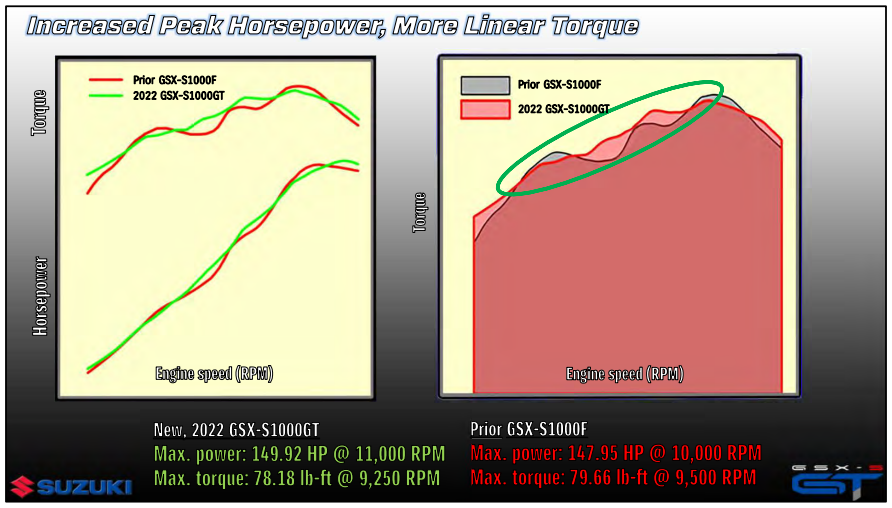
The latest refinements in the K5 Suzuki engine were not aimed at making more power but at smoothing out the torque curve. The result is smooth power at a wide range of engine speeds. Suzuki illustration.
The third big pleasant surprise wasn’t as apparent until we got out into the curvy, empty mountain roads and picked up the pace. The quickshifter on the GSX-S1000GT+ works great. Upshifts, downshifts, whatever throttle position, whichever gear, it doesn’t really matter. The Suzuki execs bragged about the performance of the quickshifter in the morning briefing before the ride, and the motorcycle fully backed them up. It works better than some more expensive bikes I could name.
Still focusing on the fun roads, the GSX-S1000GT+ shows its sport-bike lineage with neutral, responsive handling. The wide handlebar helps, by providing good leverage, and Suzuki kept the weight down in the 500-pound range. The fully adjustable KYB inverted fork and KYB rear shock work well until you hit the combination of higher speeds and bumpier pavement. At that point, the suspension felt too stiff and I felt like I was getting jolted around too much to feel fully planted. It’s something I would try to dial out — or at least minimize — with suspension adjustments if the bike were mine and I had time to experiment with the settings.
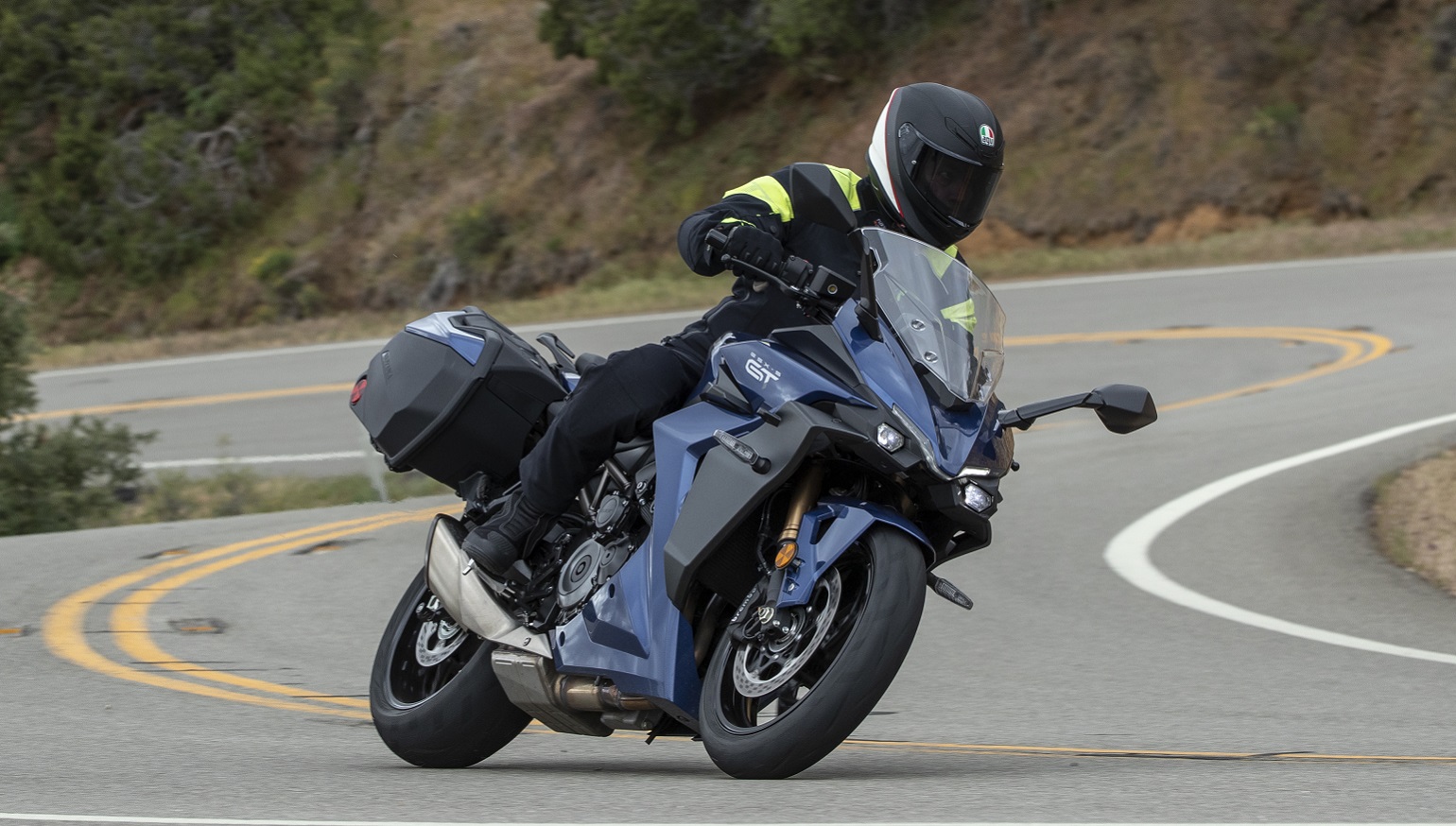
The GSX-S1000GT+ shows its sport lineage when you get to the really good roads. Photo by Kevin Wing.
The final key for handling the twisty roads is good brakes, and the Brembo setup on the GSX-S1000GT+ works well. They’re neither race-replica-strong nor grabby, and mostly I didn’t think about them at all, which is usually a good thing. The rear brake felt a little less strong than I expected, but that didn’t rise to the level of a complaint.
Suzuki has taken a different approach from other manufacturers and even from other bikes in its own lineup, such as the Hayabusa, with the ride modes. The three modes are labeled A, B, and C (Active, Basic, Comfort). While in other models, changing the ride mode changes multiple parameters, such as throttle response, level of traction control, and level of ABS intervention, on the GSX-S1000GT+ the modes only change the throttle response. All three provide the same maximum power. The difference is mainly at the low end, where A gives you the most immediate and abrupt response while C provides the softest hit of power. Independently, you can choose from five different levels of traction control. So that means you can select the ride mode based purely on your personal preference for the throttle response without worrying that other electronic aids are being changed in ways you don’t want. It’s a simple system that works.
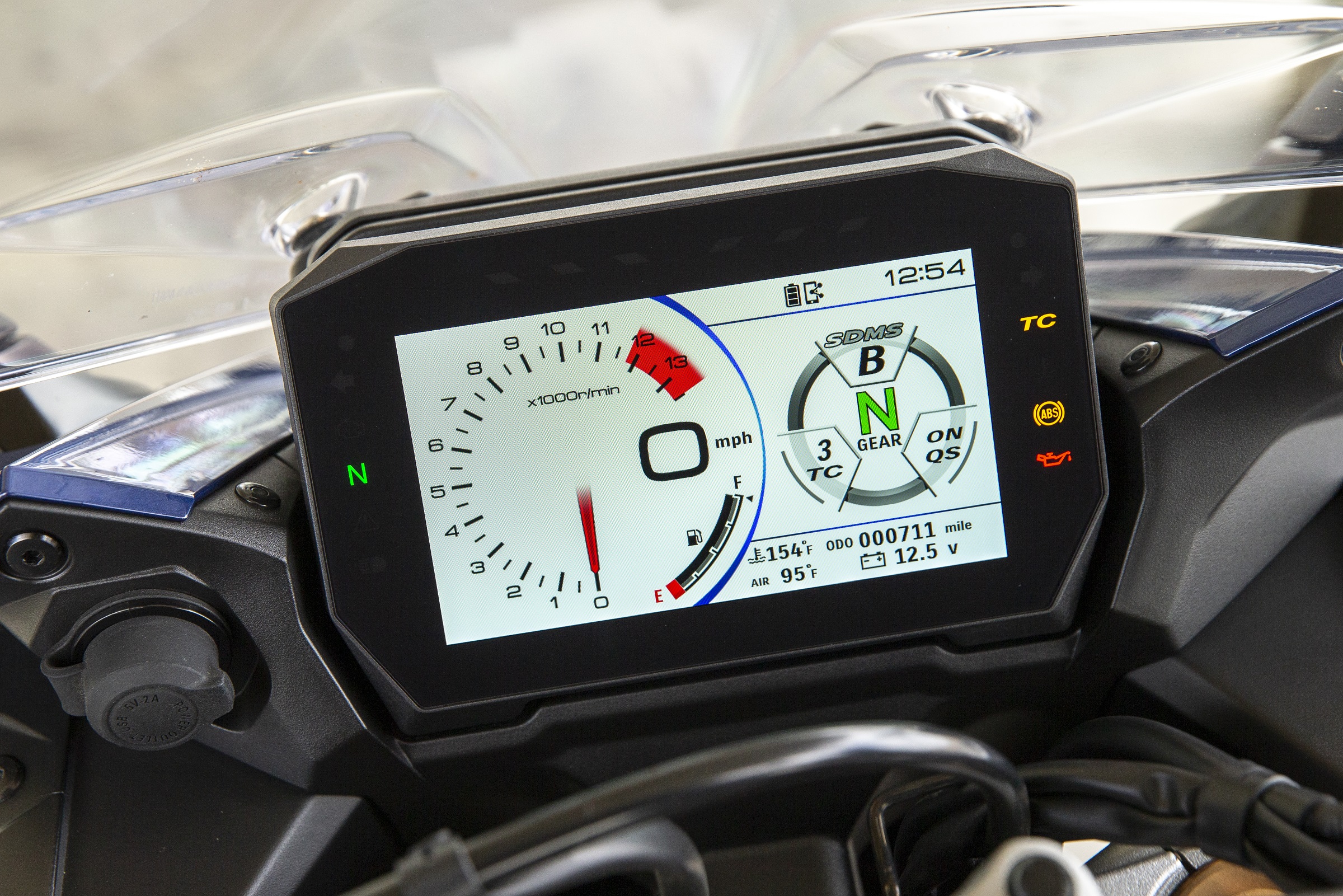
The GSX-S1000GT+ gets a new 6.5-inch TFT display that switches automatically from a white background in daylight to a black background at night. Photo by Kevin Wing.
Once we got back on some straight roads, I had a chance to test the cruise control. It turns on with a button on the right handgrip cluster and a single rocker switch on the left side allows you to set, resume, increase, or decrease speed. The cruise control worked without glitches, which is not something I can say about every motorcycle system I’ve tried.
At the end of our first day’s ride, the temperatures dropped into the mid 50s Fahrenheit and a steady rain fell. Into every sport-tourer’s life a little rain must fall, and that’s when you think about wind and weather protection. The low windscreen created a calm bubble up to my chin and didn’t cause any buffeting, allowing smooth air to flow over my helmet, which is just the way I like it. Those who prefer more coverage can buy an accessory windscreen that’s 2.75 inches taller and more vertical.
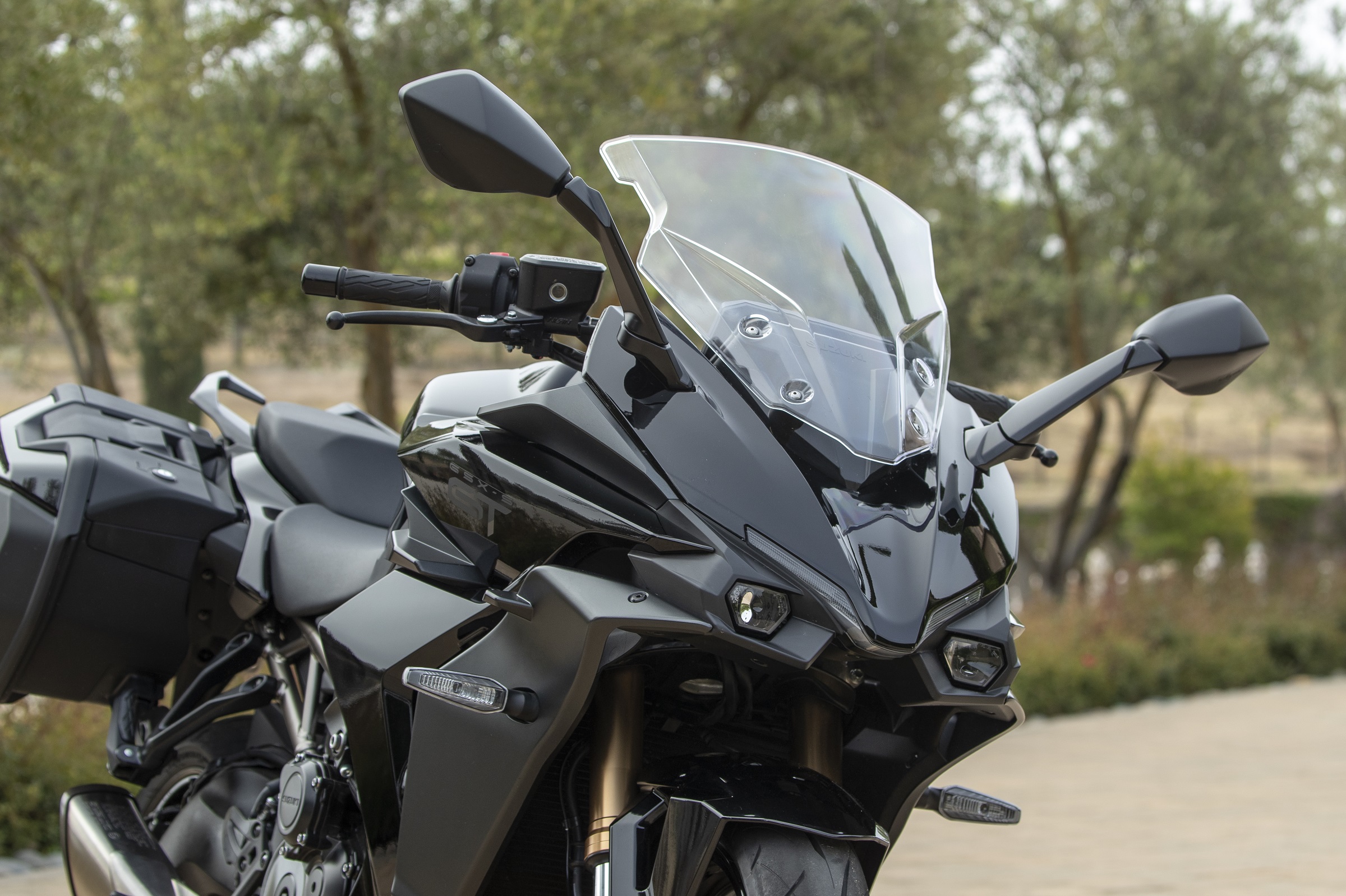
Because of the way they are focused, the LED headlights can be much smaller than usual. The V-shaped running light above and the sharp nose of the GSX-S1000GT+ create a unique face. Whether you like it or not is up to you. Photo by Kevin Wing.
What are the downsides of the Suzuki GSX-S1000GT+?
So far, you haven’t heard me say a negative word about the GSX-S1000GT+. But it will fall short for some riders, not because of how well it works — it works great — but for what it lacks. Sport-touring riders often have a list of features they demand, and since the Suzuki aims at the sportier, more elemental side of the sport-touring spectrum, it may be missing features you consider necessary.
For example, there’s no centerstand or an option for one. Suzuki took some criticism in the past for oversized mufflers, and they addressed that by tucking dual catalytic converters under the engine, which keeps the weight low and the silencer small. But it leaves no room for a centerstand, something that some riders demand on a chain-drive motorcycle that may see multi-day trips.
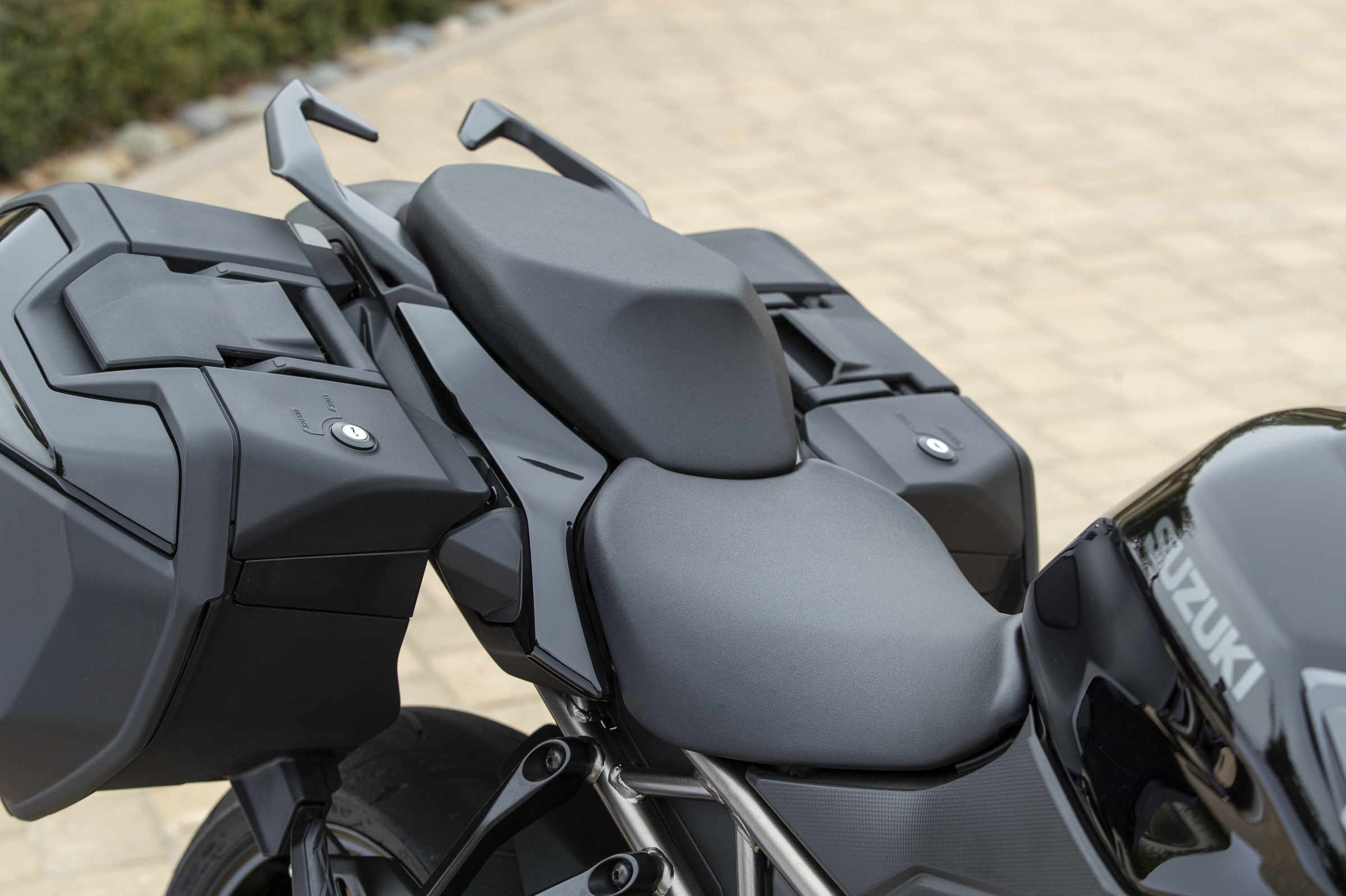
The color-matched, locking saddlebags work well and proved to be waterproof on our ride. The rider’s seat is flat and firm, and you’ll probably want a break about the time you need to fill the gas tank. I believe the passenger seat was designed more for a sporty look than for long-haul comfort. I showed a photo to my favorite passenger when I got home and her reaction included language I don’t typically use on The Ride So Far. Photo by Kevin Wing.
Compared to its most direct competitor, the Kawasaki Ninja 1000SX, the GSX also has less sophisticated electronics. There’s no inertial measurement unit so the traction control and anti-lock brakes do not take lean angle into account. Those who want the latest and most complete suite of rider aids will steer toward the Ninja or other competitors that are more expensive.
The GSX-S1000GT+ gets an extra half gallon of fuel capacity over the GSX-S1000F it replaces, but with expected mileage in the mid-30s per gallon, that still leaves you short of the 200-mile range many touring riders want. Also, the GT wants 90 octane or better, which can add up over the long run. At one point, the Suzuki corporate card was getting dinged at the rate of $6.49 per gallon to fill our tanks with premium. That’s California prices for you!
Finally, unlike the Ninja 1000SX, the GSX-S1000GT+’s windscreen is not adjustable.
Are any of those deal-breakers for you? If you absolutely have to have an IMU or a centerstand or one of the other features the GT is lacking, then you’ll shop elsewhere. For that matter, some people demand a bike have shaft drive before they will consider traveling on it. But if the Suzuki checks the boxes on your list, there’s no reason not to give it serious consideration.
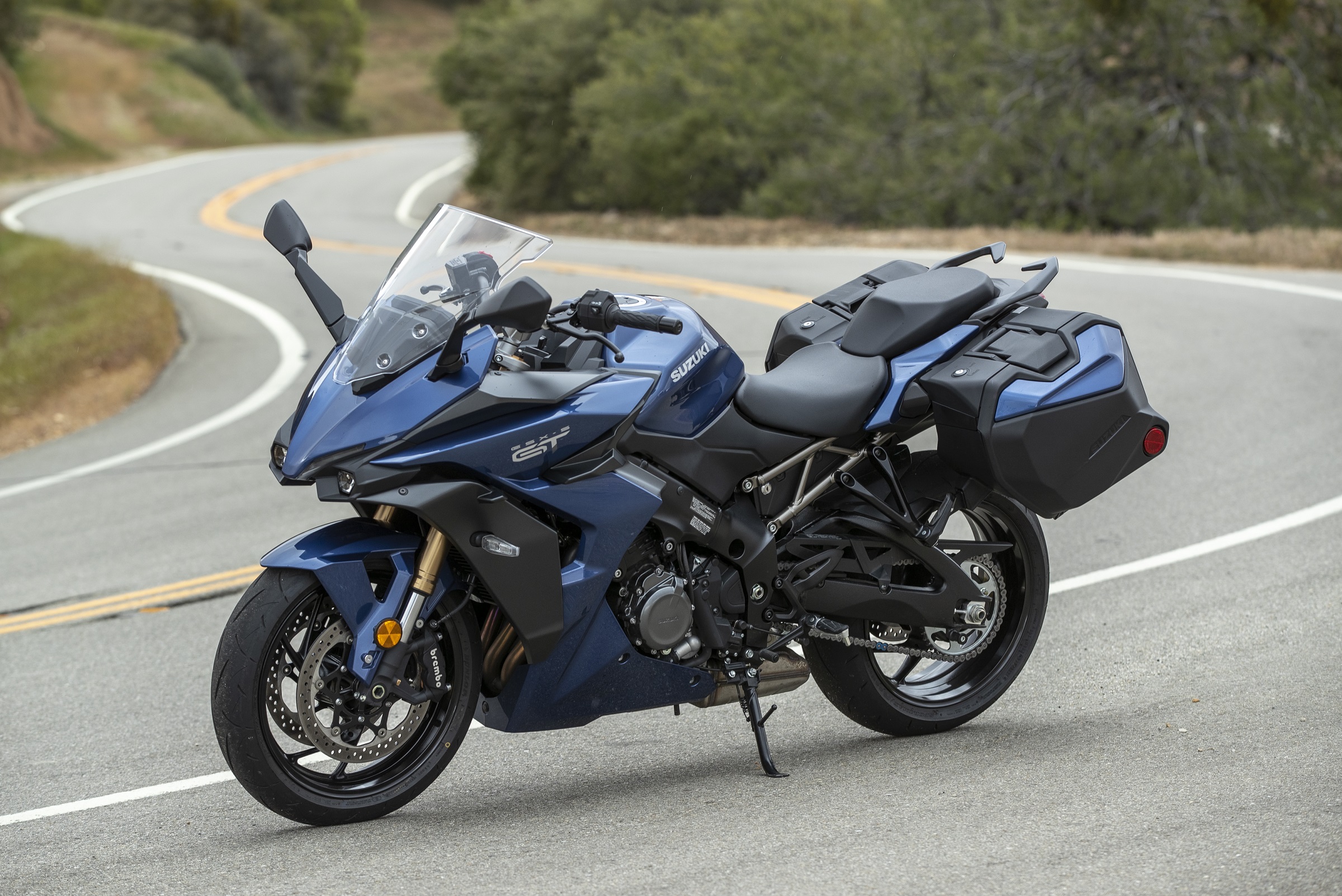
You won’t find many fully equipped sport-touring motorcycles on the market these days for under $15,000. Photo by Kevin Wing.
A sport-touring value proposition
Technically, these are two models, the GSX-S1000GT at $13,149 and the GSX-S1000GT+ at $13,799. The only difference that the GT+ comes with the color-matched 36-liter side cases. At $650, the luggage is a bargain. It would cost you more than that to add comparable aftermarket luggage that wouldn’t be keyed to match your bike and would require brackets that would be unsightly when the bags are removed. If you buy the GT, you can change your mind and add the Suzuki side cases later, but it will cost more that way.
The luggage easily swallowed my MS-size AGV K6 helmet and it remained totally waterproof in the showers we rode through.
To get back to my original point, the GSX-S1000GT+ shows that the traditional sport-touring motorcycle is not dead yet. Compared to my personal ride, a 2014 Honda VFR800 Interceptor, which was long considered the embodiment of sport-touring, the GSX-S1000GT+ is more powerful, lighter, and has more modern electronic aids. And my VFR800 is simply no longer available as a new model. But the Suzuki and its Ninja competitor carry on as very capable examples that come in well under the $15,000 mark and you can always spend a little more and move up to more powerful bikes like the Kawasaki Ninja H2 SX SE or bigger and more comfortable rides like the Yamaha FJR1300ES. Not to mention those pseudo-ADV bikes encroaching on sport-touring territory.
Suzuki is sometimes criticized for reaching into the parts bin and mixing and matching to come up with a “new” model. In my estimation, something doesn’t have to be all new to be really good. In the GSX-S1000GT+, Suzuki has built a competent and fun motorcycle that’s competitive with its strong competition on the first try.
Long live the sport-touring motorcycle.
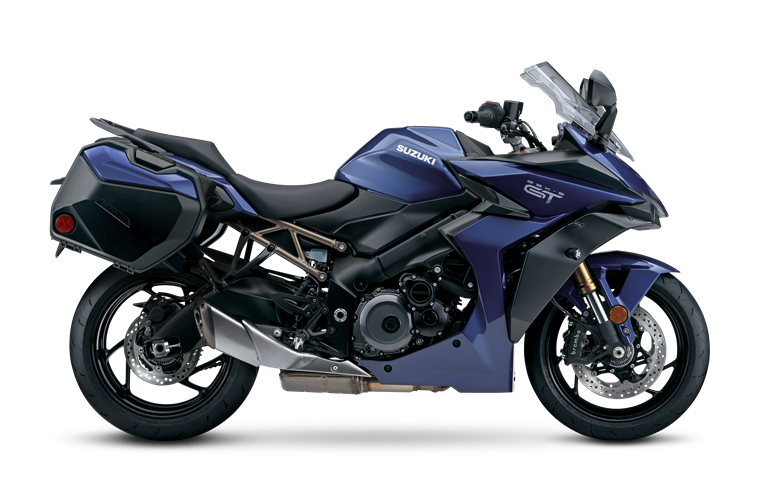 2022 Suzuki GSX-S1000GT+ |
|
|---|---|
| Price (MSRP) | $13,799 ($13,149 for GT without side cases) |
| Engine | 999 cc, liquid-cooled, 16-valve, four cylinders |
|
Transmission, final drive |
Six-speed, chain |
| Claimed horsepower | 149.92 @ 11,000 rpm |
| Claimed torque | 78.18 foot-pounds @ 9,250 |
| Frame | Twin-spar aluminum |
| Front suspension | KYB 43 mm inverted fork, adjustable for preload, compression and rebound damping; 4.7 inches of travel |
| Rear suspension | KYB shock, adjustable for preload and rebound damping |
| Front brake | Dual Brembo four-piston calipers, 310 mm discs, ABS |
| Rear brake | Single-piston Nissin caliper, 240 mm disc, ABS |
| Rake, trail | 25 degrees, 3.9 inches |
| Wheelbase | 57.5 inches |
| Seat height | 31.9 inches |
| Fuel capacity | 5.0 gallons |
| Tires | Dunlop Roadsport 2 120/70R17 front, 190/50R17 rear |
| Claimed weight | 498 pounds (without side cases) |
| Warranty | 12 months |
| More info | suzukicycles.com |

I have a VFR like you. I’m not planning to make a change any time soon, but this is a possible replacement if I do. How would you compare the two?
I was asked the same question by a reader over at RevZilla. The comparison isn’t really fair because some of the differences, such as the level of electronic aids, are mostly due to age. But here’s my take.
The Suzuki is obviously more powerful and lighter. Downshifts for passing maneuvers are more necessary on the smaller Honda. The weight difference shows up mostly at low speeds. I like the handling on both motorcycles.
As mentioned, the Suzuki’s electronic rider aids are much more advanced, even though they’re a step down from current levels in something like the Ninja 1000SX. My 2014 has rudimentary, non-adjustable traction control and ABS, and that’s only because it’s the VFR800 Interceptor Deluxe model. The base model lacks even that.
The riding position is significantly more upright on the Suzuki. Leg room is not that much different, but the forward lean is greater on the Honda. I would go so far as to say that the two define the spectrum on the sport-touring riding position — the VFR at the sporty end and the GSX-S at the touring end.
Ironically, the VFR has a bit of a touring advantage with legitimate 200-mile range due to its extra half gallon of fuel capacity and its better mileage. Plus it runs on 87 octane, which will reduce your travel expenses compared to the Suzuki.
Really, it’s hard to make a straight comparison between an eight-year-old model that’s no longer in production and a new bike. If a truck ran over my VFR tomorrow and I wanted to replace it with a new model that performed the exact same function, I’d be choosing between the GSX-S and the Ninja 1000SX, and I don’t think I’d be disappointed with either. But in reality I’d probably do something foolish like go buy some half-naked used bike and start fabbing up luggage for it, since that’s been my pattern in the past.
I would also note that the price of a GSX-S1000GT+ in inflation-riddled 2022 is about the same as the MSRP of my Honda VFR800 Interceptor Deluxe in 2014, and that’s without the Honda side cases! That makes it clear why the VFR800 didn’t sell, I think. And why I didn’t buy one new. I waited until it was six years old and half price.